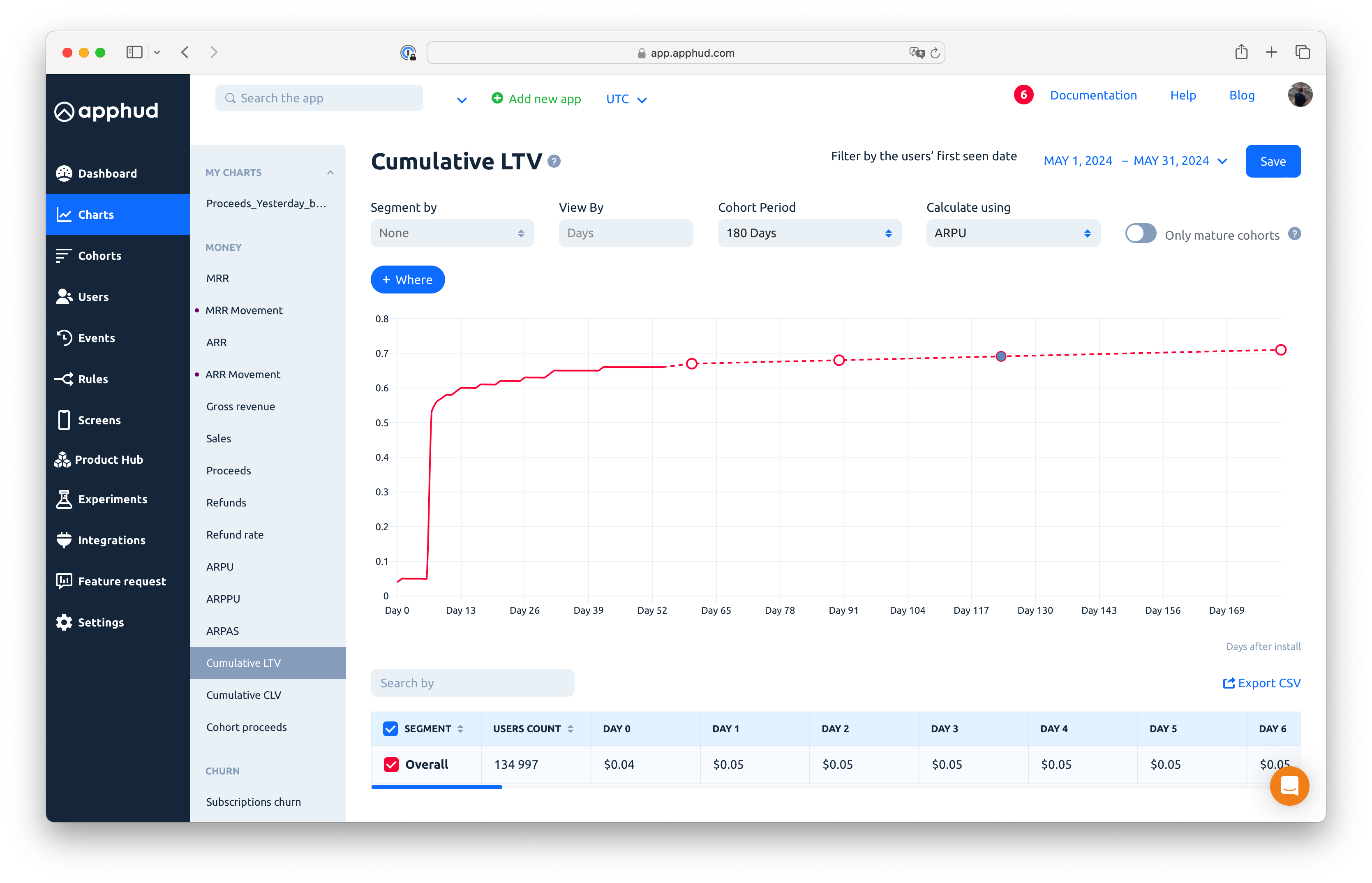Cumulative LTV
Definition
The Cumulative LTV is a cohort chart that indicates a cumulative (accumulative) revenue per user.
In this chart, revenue reflects Proceeds, which are calculated after deducting refunds, store commissions, and VAT.

Segments
Segment By
There are various segments that can be applied to the chart: Country, Platform, OS Version, etc.
Note that segmentation by the Subscription metrics (Product, Paywall, Base Plan) is not available if Calculate using ARPU was selected since non-paying users cannot be included in this segment. Select Calculate using ARPPU / ARPAS instead.
Cohort Period
The max cohort period, can be 30, 180, 365 or custom value in days. For example, if 180 days were selected, the chart will show data up to 180 days. If custom value of 999 days were selected, the chart will show data up to 999 days.
Calculate Using
The following calculation methods are available:
- ARPPU Average revenue per paying user. When this method is selected, the chart shows average revenue per paying user cumulated by days.
- ARPU Average revenue per user. When this method is selected, the chart shows average revenue per any user cumulated by days.
- ARPAS Average revenue per any subscriber (all paying users and free trial subscribers). When this method is selected, the chart shows average revenue per any subscriber cumulated by days.
This is a cumulative dynamic of how the average revenue from a selected group of paying users grows within the selected cohort period (i.e. days after installation).
Predictions
This chart can show LTV Predictions for up to 365 days into the future. For more details, refer to the Predictions guide.
Only Mature Cohorts
When enabled, this option shows only full (mature) cohorts with at least N days of lifetime. By default, all cohorts are used for prediction calculations, including those with a lifetime of less than N days.
For example, let's say you are analyzing the Cumulative LTV of users who installed your app over the past 30 days:
- Cohort A: Installed on January 1, 2024 (60 days old)
- Cohort B: Installed on January 15, 2024 (45 days old)
- Cohort C: Installed on January 30, 2024 (30 days old)
If today is March 2, not all of these cohorts have lived more than 45 days. This means, if "Show only mature cohorts" is enabled, the chart will display Cumulative LTV on the 45th day only for users from Cohorts A and B, since Cohort C has lived only 30 days. Otherwise, the LTV will be calculated from all users, resulting in the cumulative LTV chart for the 45th day and later being calculated from all users.
When you enable the "Show only mature cohorts" option and set N to 90 days, the chart will filter out any cohorts with less than 90 days of data. In this case:
- Cohort A and Cohort B will be included in the calculations because they have at least 90 days of data.
- Cohort C will be excluded because it has only 30 days of data.
What This Means
Without the "Show only mature cohorts" option:
- The chart includes all cohorts (A, B, and C), which might introduce noise and less accurate predictions due to the immature data from Cohort C.
With the "Show only mature cohorts" option enabled:
- The chart includes only Cohort A and Cohort B, providing a more accurate and stable prediction of cumulative LTV by excluding the immature data from Cohort C.
This ensures that the LTV calculations and predictions are based on cohorts with sufficient data, leading to more reliable insights.
Updated 9 months ago
